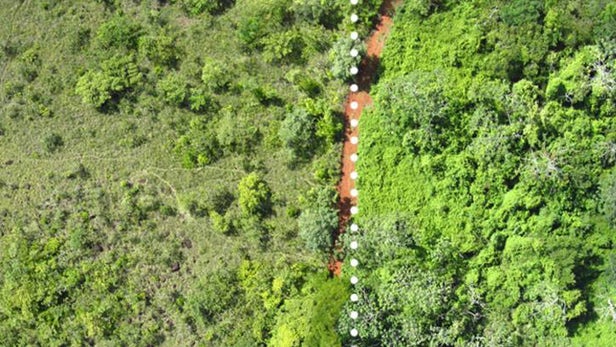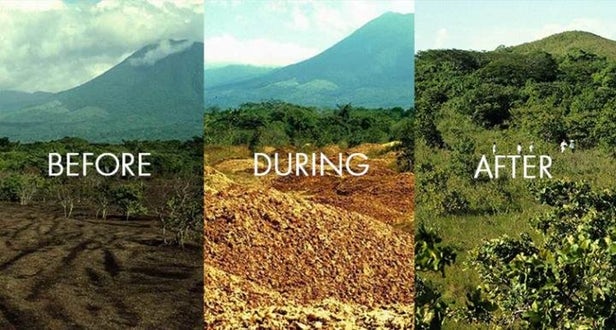The story of how discarded orange peels turbocharged a Costa Rican forest

On the right is the lush forest that was loaded with orange peel waste and on the left is the untreated land (Credit: Tim Treuer)
Sixteen years after a controversial biodegradation plan allowed 1,000 truckloads of orange peels to be unloaded onto a barren, deforested area of Costa Rican land, a team of Princeton researchers has discovered unexpectedly positive results. The area that was covered with orange waste is now a lush, overgrown forest with richer soil and more tree species than the adjacent land that was untreated.
The Area de Conservación Guanacaste (ACG) is a World Heritage-listed and government-managed conservation area in northwestern Costa Rica. In the early 1990s, it was discovered that a large-scale orange plantation was being established on one of the ACG's borders in order to sustain a new orange juice manufacturing plant called Del Oro.
In 1996, two ecologists from the University of Pennsylvania, who had worked for many years with the ACG, had a radical suggestion. What if the organic waste from the orange juice factory could be recycled to accelerate the reforestation of some barren spaces in the conservation area?
A deal was signed and the orange juice company dumped 12,000 metric tons of orange pulp and peels onto a three-hectare stretch of former cattle pasture. Many newly designated conservation areas in the ACG suffer from rocky, nutrient-poor soils due to the prominent history of overgrazing and fire-based land management in the region. The hope was that this plan would be the perfect synergy between industry and conservation.
The initial results were positive, yielding rich black soils and a variety of multi-species broadleaf herbs. A follow-up deal was struck between ACG and Del Oro, with ACG agreeing to take 1,000 truckloads of orange waste a year for 20 years.
But all was not well in the competitive orange juice business in Costa Rica.
A rival orange juice company, Ticofruit, was not happy with the deal between the government and its competitor, so it launched a court case against Del Oro, claiming this dumping of orange waste was "sullying a national park." Despite the fact that the original deal was actually between the government and Del Oro, Ticofruit's lawsuit went all the way to the country's Supreme Court and politics ultimately prevailed over common sense.
Ticofruit won the lawsuit, and the court determined the deal between ACG and Del Oro must be terminated. Progress on the initiative halted, and the land strewn with orange peels was left alone, untouched for the following 15 years.
Fast forward to 2013 and Timothy Treuer, a graduate student at Princeton was on the hunt for research topics. In his talks with one of the original ecologists who worked on the ACG project it was suggested that a follow-up study on the effects of the orange peel on the land had never been properly done. So Treuer went to visit the site and was stunned by what he found.
"It was so completely overgrown with trees and vines that I couldn't even see the 7-foot-long sign with bright yellow lettering marking the site that was only a few feet from the road," says Treuer. "I knew we needed to come up with some really robust metrics to quantify exactly what was happening and to back up this eye-test, which was showing up at this place and realizing visually how stunning the difference was between fertilized and unfertilized areas."
He returned to the site in 2014 with a team and thoroughly examined just what was going on inside this lush, overgrown forest. Comparing the orange-peel site with an adjacent control plot, the team found the orange-peel site had accelerated in growth significantly compared to the control.
As well as a three-fold increase in the richness of woody plant species, the team calculated a 176 percent increase in aboveground woody biomass compared to the control area. Deep in the soil the team also identified significantly elevated levels of macro and micronutrients.
"Plenty of environmental problems are produced by companies, which, to be fair, are simply producing the things people need or want," say study co-author David Wilcove. "But an awful lot of those problems can be alleviated if the private sector and the environmental community work together. I'm confident we'll find many more opportunities to use the 'leftovers' from industrial food production to bring back tropical forests. That's recycling at its best."
The project not only highlights how the industrial impact on land can be mitigated through clever environmental work, but how agricultural waste can actually prove to be beneficial in regenerating land that has previously been damaged.
The team's research study was published in the journal Restoration Ecology.
Sources: Princeton University, University of Pennsylvania



